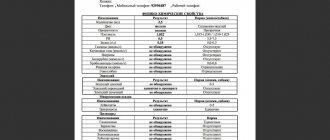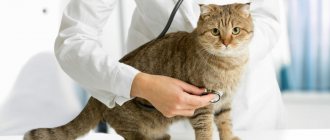Reading time: 5 minute(s) If your pet exhibits symptoms of kidney failure, contact your veterinarian immediately. Without treatment, serious complications are possible.
If the diagnosis of “renal failure” is left without proper attention or is not responded to in a timely manner, the cat’s health will deteriorate sharply, and even death is possible. There is no need to take risks; it is better to contact a veterinarian at the first suspicion. An experienced specialist will accurately determine the stage of the disease, prescribe an effective course of treatment, and advise proper nutrition. In general, he will do everything possible to ensure that the pet is cheerful, cheerful and healthy again.
CRF is a deadly pathology
Why is kidney failure dangerous for cats?
Kidney failure in cats requires treatment as soon as possible. And these are not empty threats. Every day the urinary system will work worse, and more toxic substances will accumulate in the body. They are not excreted; they poison internal organs and blood. Also, the kidneys stop coping with such tasks as:
- control of sodium intake into the blood (important for lowering and increasing blood pressure);
- regulation of fluid in muscle tissue;
- production of vital hormones;
- removal of toxins after drug treatment.
Genitourinary system of cats
There are cases when a pet fades away in a few days, and such consequences are real in both acute and chronic renal failure. Another problem is misdiagnosis. Signs of the disease often overlap with symptoms of other ailments, so the doctor’s experience is important here.
Features of the diet
When feeding your pet special food, it is important to ensure constant access to clean water.
If the owner has chosen to provide medicated food for cats with kidney failure, then it is necessary to calculate the nutrition, taking into account the weight of the animal. Food should be given in small portions. In this case, the diet requires feeding the cat products or feed with a reduced content of phosphorus and calcium. It is equally important to provide your pet with free access to drinking water. It also happens that when a cat is ill, it refuses to eat, which is associated with attacks of nausea and vomiting. In this case, it is possible to feed sick animals with infant formula for several days using a syringe.
Kidney Failure in Cats: Symptoms and Signs
Kidney failure may not manifest itself for a long time, and only after about 70% of the kidneys' performance is lost does the disease make itself felt. The early stages of the disease are accompanied by changes in the composition and color of the animal's urine. Do you have even the slightest doubt about this issue? It is better to immediately conduct a special laboratory analysis.
Keep a close eye on your pet
The following symptoms will help you recognize kidney failure in cats:
- weakness, bad breath, refusal to eat and play actively;
- drinking large amounts of water and urinating frequently;
- diarrhea, vomiting, painful cramps (often appear at the terminal stage of the disease);
- spontaneous increase in blood pressure, ruptures of blood vessels in the eyes;
- elevated body temperature, tremors, strange behavior.
The more the body is exposed to toxins, the more pronounced the signs of kidney failure become. It is also recommended to sound the alarm in advance if you initially know that your pet has ailments such as diabetes, pneumonia, piroplasmosis, and enteritis.
Chronic and acute renal failure in cats: how to treat
The choice of treatment method directly depends on the animal’s health condition and the type of renal failure. For example, in case of a chronic illness, it will no longer be possible to restore the kidneys, since, unfortunately, this is an irreversible process. If acute deficiency is diagnosed, complete recovery is possible.
When diagnosed with acute renal failure in cats, an experienced specialist does not have the question of how to treat the animal? The treatment, rehabilitation and prevention regimen is chosen individually. Common methods:
- to restore the required amount of fluid in the body, droppers are prescribed (intravenous nutrition);
- at the initial stage of the disease, the doctor prescribes antibiotics and vitamin injections;
- in order to normalize blood pressure and prevent damage to capillaries, special heart medications are used;
- in some cases, artificial blood purification and blood transfusion are prescribed (especially important in chronic renal failure).
If the pet is in pain, painkillers are prescribed, and nerve endings may be blocked. Treatment methods cannot be chosen without diagnostic data, because for high blood pressure some medications are suitable, for anemia - completely different ones, for concomitant kidney problems - still others.
List of the best dry cat food
Food for cats with kidney failure is produced by many well-known manufacturers. It can be either dry or wet. Do not forget that when eating dry food, the cat must drink a lot of water. Therapeutic food for cats with kidney failure has a positive effect on the animal’s condition. The best are considered:
- Eukanuba Renal. Food can be dry or wet. Balanced. Contains essential vitamins and microelements, as well as a small amount of protein and a low concentration of phosphorus. Can be taken for up to six months. One package of wet food 85 g costs about 50 rubles, a package of 2 kg costs 1 thousand rubles, 12 kg costs 5 thousand rubles. Made in the Netherlands.
- Royal Canin Renal. Designed specifically to support kidney function. This is a product with a small amount of phosphorus, fatty acids, and antioxidants. The fish oil content here is normalized, which helps to increase glomerular filtration, and the amount of protein is kept to a minimum. The price of 4 kg is 2.5 thousand rubles, 2 kg is 1.5 thousand rubles, and 0.5 kg is 500 rubles. The food is made in France.
- Hills Prescription Diet K/D Feline Renal Health. Improves the pet's quality of life. Prevents the progression of the disease. Contains Omega-3. Neutralizes the negative effects of free radicals. It has an excellent taste and is liked by animals. The cost of 1.5 kg of feed is 1,500 rubles, 400 g is about 350 rubles. Made in the USA.
- Farmina Vet Life Renal. The food contains about 26% crude protein, which meets all standards for medicinal feed. Contains carbohydrates and fatty acids. Easy to digest. After 3-4 weeks of its use, pets feel significantly better. Price: 2 kg - 1500 rubles, 5 kg -3500 rubles, 0.4 kg - 400 rubles. Factories producing these feeds are located in Italy, Serbia and Brazil.
- Monge Grain Free Vetsolution Renal Feline. The food does not contain grains. It is based on freeze-dried chicken. Contains up to 24% protein. They are recommended for cats not only for diseases of the renal system, but also for exhaustion, anorexia and metabolic acidosis. Sold only in veterinary institutions. Packaged in 0.4 and 1.5 kg. The price of 400 g is 350 rubles, 1.5 kg is 1100 rubles. Made in Italy.
- Purina Veterinary Diets NF. The food has excellent taste. All cats eat it without exception. The composition includes rice, corn and wheat flour. There are animal fats, minerals and powdered eggs. The protein content reaches 26%. The cost of 350 g is 300 rubles, 850 g is 650 rubles, 1.5 kg is 1000 rubles. Product made in France.
The composition of medicinal feeds is carefully developed. For their production, only fresh, first-class raw materials are used. And the effectiveness of the products has been confirmed by the World Association of Veterinarians.
How long do cats with kidney failure live?
If we are talking about acute renal failure, then with proper treatment, the animal will return to a full life. Although, since the pathology of renal failure is not eliminated, the cat will always require careful care - diet, periodic visits to the veterinarian. If the disease has reached the terminal stage of chronic renal failure, then, unfortunately, treatment will no longer help. It is unknown how long the pet will live at this stage. It depends on his age, the condition of other organs, and care. In the most severe manifestations of the terminal stage, the animal is euthanized, since chronic renal failure is accompanied by excruciating pain.
An animal with chronic renal failure can fade away in a matter of days
Diagnostics
To determine chronic renal failure in a cat, it is necessary to undergo the following diagnostic procedures:
- Clinical and biochemical blood tests
- can show anemia in the animal, an inflammatory process in the body, high levels of urea, creatinine, hypoalbuminemia, high levels of potassium, calcium, phosphorus. - General urine analysis
- to assess specific gravity (usually lower in animals with chronic renal failure), the presence of blood, bacteria, leukocytes (inflammation), and renal epithelium. - Urine test for protein/creatinine ratio
- to assess glomerular filtration rate of the kidneys. - X-ray
– can evaluate the size of the kidneys, the presence of structures in them (cysts, stones, tumors) - Ultrasound
– using ultrasound, the structure of the kidney, its size, the size of the pelvis, the presence of cysts, stones, tumor process, and congenital anomalies are assessed. The bladder is also examined. - Anamnesis collection, interview with the owner.
Information about the animal’s diet, its life, and the appearance of the first symptoms is very important for making a diagnosis, assessing the stage of the disease and finding out the possible cause. - Blood pressure measurement.
Blood pressure in cats is measured using a special tonometer by placing a cuff on the tail, front or back paw. Also, signs of chronic hypertension can be detected in an animal by an ophthalmologist when examining the fundus of the eye. - Blood gases.
This analysis allows the veterinarian to get quick results of the level of potassium, calcium, sodium, chlorine in the animal’s body and assess acidosis (a shift in the acid-base balance towards a decrease in pH). - Excretory urography
– useful for detecting ureteral obstruction, cancer or kidney stones. - Kidney biopsy
– to diagnose, for example, renal lymphoma, amyloidosis or granulomatous interstitial nephritis in FIP).
Cat with chronic renal failure: stages of the disease and signs
The big problem with chronic renal failure is that it is very difficult to diagnose the disease in the early stages. There are no special external manifestations; chronic renal failure can only be determined by regularly taking tests. Therefore, most often, at the time of diagnosis, the kidneys are already more than half affected and the animal requires serious treatment. And if you delay, a fatal outcome cannot be avoided. In total, there are 4 stages of disease development:
- compensation
- subcompensation
- decompensation
- terminal
Despite the absence of obvious symptoms of chronic renal failure in the first stages, there are signs that should attract the attention of the owner. If your cat has become less active, her appetite has decreased, and she drinks water more often, then it is worth taking blood tests. If creatinine values are elevated, do a more in-depth examination, including an ultrasound of the kidneys. In the early stages, CRF can progress slowly over months, and the sooner the owner begins treatment, the higher the chances of a positive outcome.
Treatment of acute renal failure has a much higher chance of success
If you have end-stage chronic renal failure, the maximum that a veterinarian can offer you is hemodialysis and surgery. Neither one nor the other gives a 100% guarantee of the survival of the animal. Doctors often recommend euthanizing a cat in order to save both it and its owner from prolonged suffering.









